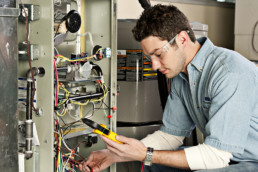How To Select The Right Central Air Conditioner System For Your Home
A central air conditioning system provides cooled or warmed air throughout the home, delivered from a single location. Unlike a portable unit that sits in a window frame, a central air conditioning unit is connected to a series of ducts that carry air beneath the floor or above the ceiling to outlet registers in every room.

Choosing the right system for the home involves several considerations. These include the volume of the home's interior, the average temperature on any given day in the region where the home is located, the energy efficiency rating of the unit, and the overall cost involved to purchase and install the system components.
Components Of A Central Air Conditioning System
A central air system consists of a condenser unit, an evaporator coil, blower, ducts, and coolant lines. The condenser unit is placed outdoors and is responsible for drawing heat from the coolant liquid. The evaporator coil and blower fan draws the air into the system, and the air is cooled as it passes over the coils. A secondary blower may also be needed if the air volume is high. This fan blows cold air through the ducts and to every room in the home.
During this process, the coolant liquid is heated because it absorbs energy from the air in and around the evaporator coils. Depending on the coolant used, the result may be a transition from a liquid to a gas state. This coolant gas is pushed outside through the outlet lines, where it is compressed and passed through another set of coils. The heat is drawn away and the coolant is returned to the indoor evaporator coils to begin the cycle once again.
Choosing The Right Size Air Conditioner
Manufacturers grade their products by their ability to produce a specific amount of cooled air. This is measured in British Thermal Units or BTUs. A total of 12,000 BTUs per hour can melt one ton of ice. As a rule of thumb, this is the amount of cooling energy needed to cool and maintain an ideal temperature for every 400 square feet of living space. If the home contains 2,400 square feet of living area, then a total of six tons would be the recommended size and output capacity of the cooling system.
However, it is advisable to have an experienced heating and air conditioning specialist give the home a thorough inspection prior to choosing a model based on cooling power. Some newer homes have more energy-efficient windows, better insulation, and exterior wall materials designed to keep heat in and cold out. This can significantly affect the size of the unit needed.
The Seasonal Energy Efficiency Rating
Abbreviated as SEER, this rating is found on the label of every air conditioning unit sold. The rating system is designed to give an accurate estimate of the total amount of electrical, oil, or gas energy needed to run the system. Most units manufactured today have a SEER rating of at least 13. The higher the rating, the more energy-efficient the system. This is a very important consideration because any type of central air conditioning unit costs a significant amount of energy to operate, especially during the hot summer months.
Types Of Coolant
In the 1980s, CFCs were being phased out as a cooling refrigerant liquid because of their effect on the earth's ozone layer. Freon become the favored coolant, but in 2010 the federal government made an amendment to the Clean Air Act that required new models to become even more environmentally friendly. Today, the most favorable coolant leaving the smallest environmental footprint is R-410A, similar to Freon but manufactured in a way that does not introduce dangerous toxins into the atmosphere as it is being produced. Most new units are built to handle this coolant, and as more units are sold that rely on R-410A, its cost will continue to decline.
Specific Energy Saving Features
Homeowners considering the purchase of an all-in-one heating and air conditioning system are encouraged to look for models that have advanced energy efficiency construction. Specifically, items to look for include an automatic delay fan switch, a variable-speed blower, a high-temperature operation rating of at least 11.6, and oversized evaporator coils.
An automatic delay fan switch allows the fans to operate for several minutes after the coolant flow is interrupted by the home's thermostat. This allows residual cool air to recirculate, saving the owner money. A variable-speed blower reduces the amount of energy needed to operate the blower motor.
A high temperature rated unit has a special expansion valve that allows the unit to operate more efficiently when the outdoor temperature rises above 90 degrees Fahrenheit. Oversized evaporator coils mean a larger volume of air passes over the surface of the coils using the same amount of energy by the fan and blower motors.
Advanced Technology Thermostats
The home's thermostat settings control how much energy will be used to operate the system. Some of the modern thermostat models are completely programmable. They can be preset to change the base temperature level at various times of the day. For example, the home's interior air temperature may be affected less during the late night hours, so the system can be set to run alternately on cool mode or just fan mode. These programmable thermostats can also be set to change the temperature swing at the desired time of day. The narrower the temperature swing - a 2-degree or less swing is desirable - the more efficient the central air conditioning system operates.
The easiest way to get the best air conditioner for your home, however, is to call Mahle Cool Air. Our Technicians are fully NATE certified and will select the best AC or heat pump for your home, not just for technical reasons but also to fit your budget. Call or Text us today for more details (941) 203-7955 and don't forget to check out our specials, financing, and rent-to-own air conditioning options.
Stay Cool Daily With Mahle.
Fix Your Old AC or Replace it With a New One
For the past few years, summers have brought with them hot temperatures and high humidity. These scorching temperatures have proven to be not only uncomfortable by life-threatening to many. Everyone has either been getting out their AC systems or buying new ones. Each spring, the main question is whether to fix the old AC or replace it with a new one. Here are some things you might consider when contemplating the decision.
How Serious is the Problem?
If you AC isn’t working correctly, it could be something major like a faulty compressor or it could be something as simple as a clogged or dirty filter. Simple fixes can be not only inexpensive but can also add months or years to the life of your AC system.
Sometimes a good cleaning is all the system may need. If you’re not mechanically inclined, you may want to have a service technician check out your AC system. Maintenance checks are usually not real expensive and the technician can give you an informed answer on what it will take to get the system running as it should.
How Energy-Efficient is Your System?
We hear a lot about saving energy and being as energy-efficient as possible. This is a good idea since energy costs are at an all-time high. Although your AC may still be operating fairly good and kicking out a sufficient amount of cool air, how efficiently is it running? Hot summers that have your AC system running a lot are going to result in higher energy bills
However, if this cost seems exceptionally high or much higher than previous years, you may want to consider getting a new energy-efficient model. Sometimes, the amount you save in energy costs almost pays for the unit in just one year.
How Old is Your AC System?
The age of the AC system is generally the major consideration when consumers are contemplating what to do to meet their AC needs. How much and how heavily the system has been used will also play a factor. Some people only use their system on extremely hot days and supplement it with fans.
Other people, on the other hand, use the system almost non-stop from spring right until fall. The lifespan of AC units is usually around ten years. If your AC system is less than five years old, it may be work keeping and just having it serviced. Service technicians can often add years to the life of an AC system with just a simple maintenance check each year.
If the system is nearing its lifespan or has exceeded the ten-year span, it may be time to replace the unit. Keep in mind also that if the unit is that old, it’s probably not efficient anymore.
Is the Problem the AC or Your Home?
Just because your home was insulated ten years ago, doesn’t mean it’s still adequately insulated. Are your windows and doors sufficiently sealed or is air entering and leaving the home through cracks? Are your vents clean and allowin67g the air to flow freely?
Sometimes what homeowners think is an AC problem may be things that need fixing in the home. Another thing to consider is the size of the AC in relation to the size of the home. When you purchase an AC system, the technician will generally tell you how many square feet the system will cover.
On a window unit, this information will be listed on the box. Follow these guidelines. If you get an AC unit that’s too small for the area you want to be cooled, it’s not going to adequately keep your home cool and will ultimately cost you more in energy costs. Call or Text us today for more details (941) 203-7955 and don't forget to check out our specials.

